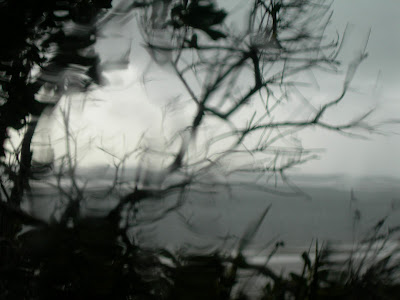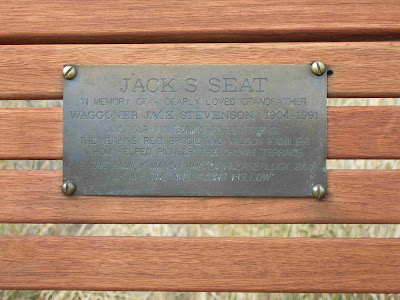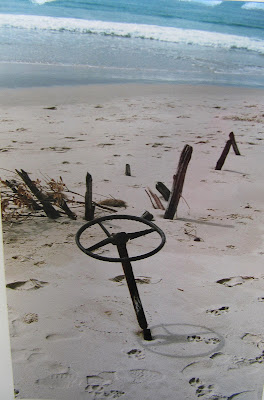When the dying's done, the dead are not silent.
They are remembered long after they are gone, bookmarked with tombstones, plaques - and our own personal memories.
Here are a few ways that we have given the dead a voice.
But first, let me set the mood:
 |
| Funeral weather |
Now you are suitably chilled, your tour of the dead starts in New Zealand, with Jack's seat.
It recalls a dearly loved grandfather who lived long (1904-1991) and left behind a seat with this plaque which looks across valley near Queenstown.
It concludes 'as the family march ahead please look back as we the ancestors follow'.
 |
| Jack's seat |
 |
| The view from Jack's seat |
Jack opted for a view and offered a seat to the passers by.
Other people choose a less solitary style with community living (so to speak) in the cemetery, there to rest among their fellow dead away from the chatter of daily life.
|
| Sunlight and shadow |
Such cemeteries are where we find history. This Boston cemetery is the resting place for Paul Revere.
 |
| Boston |
 |
| Paul Revere's plaque |
Pompeii
This was one monumental burial. When the volcano Mount Vesuvius erupted in AD79, it buried the entire town in ash and pumice. It stayed buried for 1,700 years, yet the dead were still able to speak to us when they were unearthed.
Here are the preserved remains of two.
These figures are distressing: their last moments are frozen and we get to watch. They were buried before their time, so to speak.
The Titanic
This heart breaking tragedy, just beyond our living memory, was the sinking of the Titanic on April 15, 1912. Over 1,500 people went down with her, and many of the dead went unburied.
Only 329 bodies were recovered, and 119 were buried at sea. Many could not be identified so they were given a number.
Later, using such clues as clothing, some of the dead could be claimed by their relatives. Others had be buried with a number alone. Ultimately, 150 Titanic victims were buried in Halifax, 44 of whom were never identified.
(My thanks to Rodger who made the expedition to the Halifax Cemetery to take these photos.)
 |
| An Australian, one of Titanic's victims: Arthur Gordon McCrae, BE University of New South Wales |
 |
| A line up of Titanic grave stones |
 |
| No. 179 - an unidentified passenger on the Titanic |
Anne of Green Gables
One of my favourite dead people is Lucy Maud Montgomery, author of the book
Anne of Green Gables.
 |
| Resting place of L.M. Montgomery at Cavendish, Prince Edward Island |
Despite the fact that
Anne of Green Gables was a fiction, she was far more real to me than Lucy Maud.
I thank Lucy Maud for creating Anne, but she was not Anne. There was no gravestone for my Anne, so I am declaring her not dead.
And as such, Anne lives on today, speaking through her books.
World Trade Centre, New York
So many unburied here. These photos were taken in 2006.
 |
| Air space where the towers once stood |
 |
| This is a timeline of the events of September 11, 2001 |
 |
| Timeline part two |
 |
| World Trade Centre Station |
 |
| Photos of that day: note the police presence |
A cemetery near Gavle in Sweden
In Sweden, they not only bury their dead, but put them into deep freeze.
The photos of this cemetery are not black and white stills. These are full colour photos of a winter's day in Sweden, taken in late December. The scene was black and white - and bitterly cold.
In Sweden, the winter sun hangs reluctantly just above the horizon for only a few hours, so the day is half lit with a sun about to set. This photo was taken in the middle of the day.
The dead lie under a blanket of snow and in the windless chill, the silence is almost a presence.
The Port Arthur Massacre (Tasmania)
This single cross speaks of the 35 lives lost when Martin Bryant went on a killing spree in Tasmania's Port Arthur prison colony on 28 April 1996. It was - and still is - a popular tourist site. It was Australia's deadliest killing spree.
 |
| Port Arthur, Tasmania |
Last but not least: Salzburg
Salzburg does a most decorative cemetery, lush with flowers, shrubs and statues.
The dead seem incidental.
(Note: you can also tour my version of the spectacular Recoleta Cemetery in Buenos Aires. You'll find it in the post called 'Buenos Aires' in this blog.)
Rest in peace.


















